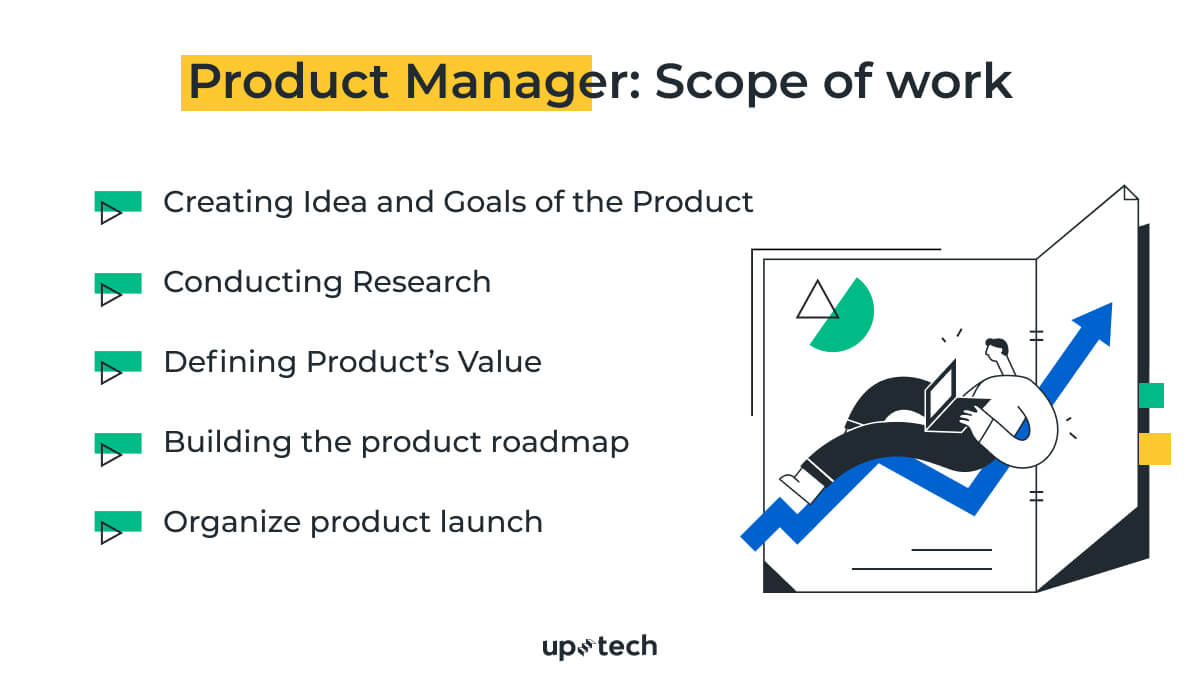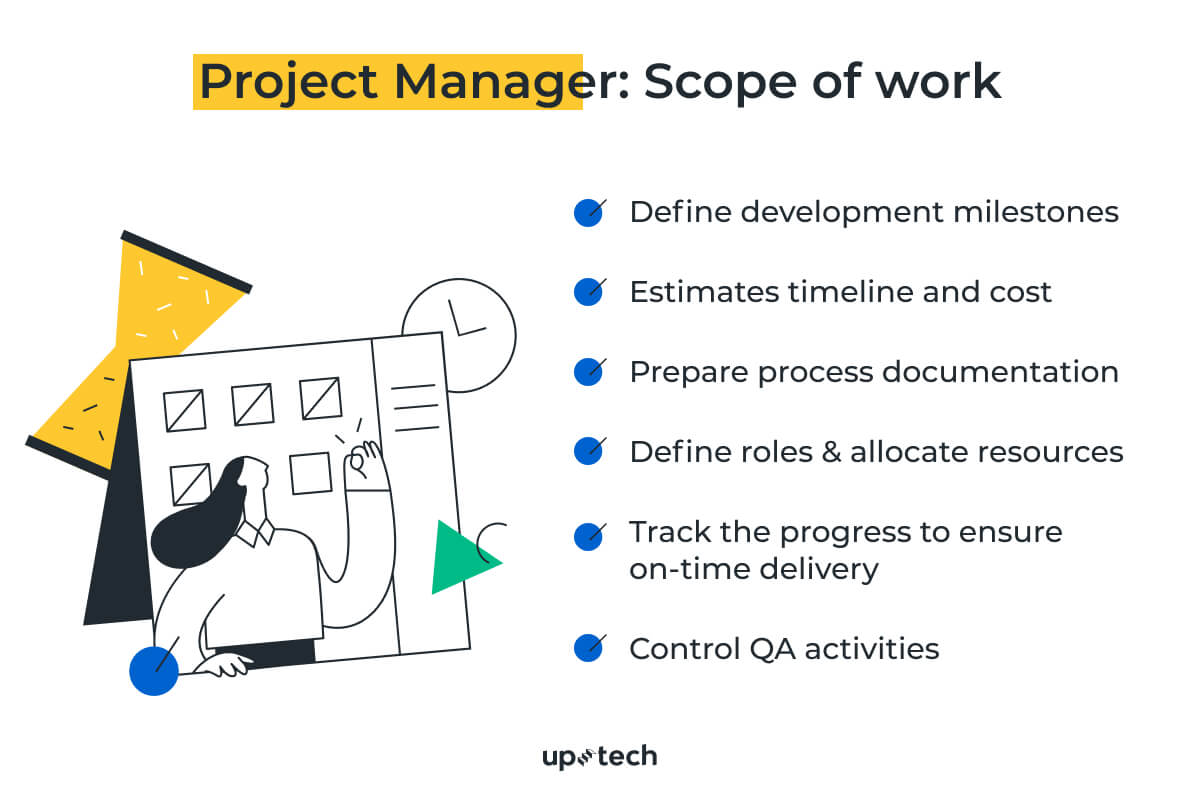The difference between a project and product managers is one of the biggest mysteries in the IT world. Even professionals have difficulty drawing a line between the two: 58% of organizations do not differentiate a project manager from a product manager.
While the two roles may largely overlap, their set of duties, purposes, and even KPIsdiffer significantly. This article will shed light on the differences between a product manager and a project manager, based on Uptech’s experience and cases, as well as industry leaders like Slack and Whole Foods.
Who Is Who?
As obvious as it sounds, a product manager does everything related to the “product”. To be precise, the product manager drives the product development lifecycle.
While a product manager is responsible for the product's market success, he/she is not actively engaged in leading a development team. Instead, a product manager's to-do list will be primarily defining the value proposition, capturing the product/market fit, and building the roadmap to achieve the project goals.
The project manager, meanwhile, is one who runs the development. Guided by the product manager's vision and defined roadmap, the project manager makes sure that the team delivers it on time and within a defined budget.
Product Manager: Scope of Work
A product manager is often referred to as the CEO of the product.

His/her mission is to build a solution that solves users’ needs and achieves goals of the business. In pursuit of this goal, he/she has the following responsibilities:
Idea and Goals of the Product
A product’s vision is the way it solves the problem of users and provides its value. The product manager is expected to work through the idea and synchronize all stakeholders opinions and build a coherent vision of the product.
Research/Defining Product’s Value
Once the product’s vision has been identified, it is essential to determine the value the product brings to users. To that end, the product manager determines several hypotheses of such value propositions and undertakes initiatives to prove or dissolve his/her assumptions.
Such initiatives may include user research, hypotheses validation, crafting a concept, and prototypes. During this process, he/she creates a customer persona(s), outlines customers’ stories and customer journey map (CJM).
For example, we used Proto Persona and CJM for hypothesis validation at the Yaza project. Yaza is a new real estate app, which allows users to record video tours of real estate items and their neighborhoods, locate them on the digital map, and share them with clients.
We started with user research and interviews with our top users to discover their needs & pains. Having users' feedback, we could finally create users' Proto Personas, CJMs, and develop the solutions to solve their problems.
The next step is finding the product’s value – a practical solution different from what competitors already offered.
A great example in this context is Slack, a workspace productivity and messaging app. The company put its value proposition in three words: “Be Less Busy.” It makes sense, as Slack boasts of having the biggest amount of app integrations on the market. Teams using Slack can have all the necessary tools gathered in one place, making the workflow smoother and less fussy.
Building the product roadmap
A roadmap is a reference document that lays out the goals, timeline, and priorities for everyone involved in the project. It communicates which features the team plans to implement and how it should do it. In other words, a roadmap provides a 360 view of all processes in product development.
Product roadmap shows:
- Where the product's going;
- Which steps need to be taken;
- What priority each part of the project has.
Roadmaps can be flexible. By using them the product manager ensures transparency in communication between investors, shareholders, and developers, streamlining the project development, marketing, and sales processes.
Organizing product launch
Along with a marketing team and CEO, the product manager is responsible for the product market launch.
That means he/she will provide consultancy on the most suitable time to introduce the product to the market. To that end, the product manager may advise the client on the best time to launch and promote the product and which promotion strategies to use.
Project Manager: Scope of Work
Unlike a product manager who crafts the vision, a project manager is responsible for the product’s technical execution. Here's what a project manager does en route to the product's launch:

Define development milestones
Simply put, a milestone stands for some achievement within the timeline of the project. One sprint includes several milestones, which follow each other until the project is complete. Setting milestones makes it easier to manage clients' expectations.
The project manager’s core responsibility is to make sure that the project is delivered on time. To that end, he/she has to analyze the product requirements, which originated from the product manager and set the milestones for every sprint of the project.
Estimates timeline and cost
Once the milestones are set, a project manager evaluates the time and cost necessary to develop the project. Such evaluation usually comes from the team's knowledge and technology applied.
Prepare process documentation
To streamline the development process and make it more organized, a project manager sets forth standards, reports, metrics, schedules for the team.
Define roles & allocate resources
After setting the timeline and budget limits, a project manager usually allocates roles among the team in a project charter document. In the document, the project manager defines the main points of the product, such as project stakeholders, the main goals, timeline and risk mitigation strategy.
Track the progress to ensure on-time delivery
As straightforward as it sounds, a project manager makes sure the project is delivered on-time. Projects usually use a Kanban or Scrum practice. Both frameworks provide several applications and tools to simplify a project manager’s job.
The progress of development moves on by sprints. Averagely, a sprint takes about 1 - 4 weeks. That said, the best option for big scope projects is 2 weeks, as it includes all the operational processes and the product development itself. Meanwhile, a 1-week period is too little, while a 3 - week sprint suffers from a feedback loop.
Control QA activities
Guided by the product’s vision and acceptance criteria, a project manager also manages the QA team. In this role, the project manager makes sure the bug reports seamlessly move from the QA to the development team.
Summary
Although the responsibilities of a product and project managers overlap, the purposes of their work are different. It makes more sense when you hire different individuals for each position, as both professionals can focus on their tasks.
Merely a development team at first, Uptech has grown into a strong product development studio. We’re now poised to help co-founders drive their product idea from inception to the market launch.
Contact our sales manager to share your idea. This could be your first step to launching a hit startup.




































































































